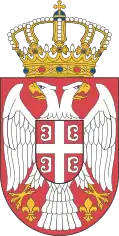
A page from the Belgrad Four Gospels printed at the Belgrade printing house (1552)
Serbian printing refers to the history of printing among Serbs, and focusing on development of book printing in Serbian, with the use of the Serbian Cyrillic alphabet, from the end of the 15th century up to the end of the 18th century.[1] The first state printing house, the Serbian Printing House, was established in 1832.
Printing houses
- Early modern period
- Crnojević printing house (1494—1496)
- Vuković printing house (1519/1520—1521) and (1536—1540)
- Goražde printing house (1519—1523)
- Rujno Monastery printing house (1537)
- Luka Primojević
- Gračanica printing house (1539)
- Mileševa printing house (1544—1557)
- Belgrade printing house (1552)
- South Slavic Bible Institute where Jovan Maleševac and Matija Popović worked as translators (1561-1565)
- Mrkšina crkva printing house (1562—1566)
- Skadar printing house (1563)
- Zagurović printing house (1569—1570)
- Rampazetto and Heirs (1597—1616)
- Trojan Gundulić
- Hieromonk Pahomije
- Hieromonk Makarije
- Josef von Kurzböck printing house, in Vienna, Cyrillic works, from 1771 until 1792 until the sale to Stefan von Novaković
- Stefan von Novaković's printing house, in Vienna, printed and published books until 1796 until the sale to the University of Pest
- Srbulje
- Radoslav's Gospel
See also
References
- ↑ Ćirković 2004, p. 138-139.
Sources
- Ćirković, Sima (2004). The Serbs. Malden: Blackwell Publishing. ISBN 9781405142915.
- Ivić, Pavle, ed. (1995). The History of Serbian Culture. Edgware: Porthill Publishers. ISBN 9781870732314.
- Samardžić, Radovan; Duškov, Milan, eds. (1993). Serbs in European Civilization. Belgrade: Nova, Serbian Academy of Sciences and Arts, Institute for Balkan Studies. ISBN 9788675830153.
External links
- Pavle Ivić, Mitar Pešikan (1995). "Serbian printing". The history of Serbian Culture. Rastko.
This article is issued from Wikipedia. The text is licensed under Creative Commons - Attribution - Sharealike. Additional terms may apply for the media files.
